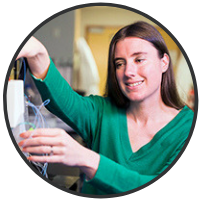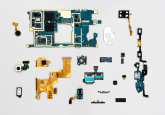Applications of 3D printing in neuroscience: engineering neural tissue models

In this interview, Stephanie Willerth (University of Victoria; BC, Canada) describes her experiences using 3D printing technologies for engineering neural tissue models.

Biography

Dr.
Stephanie Willerth holds a Canada Research Chair in Biomedical Engineering at
the University of Victoria (BC, Canada) where she has dual appointments in the
Department of Mechanical Engineering and the Division of Medical Sciences. Willerth
also directs the Centre for Biomedical Research and the Biomedical Engineering
program at the University of Victoria and runs an active research group whose
focus is developing innovative methods of engineering tissues.
Two
of her main areas of focus include 3D printing neural tissues using stem cells
and directly reprogramming somatic cells into neural tissues. Willerth’s research
group has published 49 peer reviewed journal articles and 10 book chapters. She
has also given 58 invited talks, including presenting at the 2018 Till and
McCulloch meeting (12—14 November 2018; ON, Canada), the University of
California, Los Angeles (CA, USA) and as part of the Weldon School of
Biomedical Engineering Distinguished Lecture series at Purdue University (IN, USA).
Willerth
is an active member of the steering committee of the BC Regenerative Medicine
Initiative (BC, Canada) and Staff Scientist at Creative Destruction Labs (ON,
Canada). Willerth also served as the President of the Canadian Biomaterials
Society from 2017—2018. She spent Fall of 2016 on sabbatical at the Wisconsin
Institute for Discovery (WI, USA) supported by the International Collaboration
on Repair Discoveries International Travel Award where she wrote her book ‘Engineering
neural tissue from stem cells’, published by Academic Press.
Willerth’s
honors include being named the 2018 REACH award winner for Excellence in
Undergraduate Research-inspired Teaching, a Woman of Innovation in 2017, one of
the 2015 Young Innovators in Cellular and Biological Engineering and a ‘Star in
Global Health’ by Grand Challenges Canada in 2014.
Could you briefly explain your role and give an overview of how you have adopted bioprinting technologies for neural tissue engineering?
My research program develops novel biomaterial scaffolds for directing stem cells to form functional neural tissues since I started my independent research program in 2010. Protocols for differentiating pluripotent stem cells into neural tissue often take extended time periods and require multiple steps in terms of cell selection and media changes. It was logical to investigate the use of 3D bioprinting to generate such stem cell-derived neural tissues as a high-throughput and reproducible manner when compared to traditional ways of tissue engineering. It was also convenient as Aspect Biosystems (BC, Canada) is located in our local ecosystem — collaborating with them has really enabled us to conducting cutting-edge research in the area of bioprinting as we were the second University to have one of their unique RX1 bioprinters. We are actively working on a variety of bioprinting projects.
How did you first become involved with bioprinting neural tissues?
I had always been interested in engineering neural tissues due to their complex nature that requires the replication of both appropriate structural and chemical properties. Tissue engineering offers a potential way to treat many of the neurological diseases and disorders currently lacking true cures, including Alzheimer’s disease and spinal cord injury. 3D bioprinting neural tissues derived from induced pluripotent stem cells provides an amazing opportunity to produce personalized models of such diseases for drug screening applications.
What advantages does bioprinting offer over more conventional/traditional tissue engineering approaches?
Bioprinting can help improve the reproducibility of the process of tissue engineering as well as automate the process for high-throughput generation of these neural tissues.
What challenges, if any, does bioprinting help to overcome when engineering neural tissues from stem cells?
It can potentially provide a more reproducible and less labor-intensive method for engineering neural tissues in comparison to other methods like organoids and traditional tissue engineering where individual tissues are polymerized in each well of a 24 well plate.
Are there any regulatory challenges involved when using bioprinting technologies to engineer neural tissues from stem cells?
Such engineered tissues can serve as valuable tools for drug screening without extensive regulatory approval. Developing implantable 3D bioprinted tissues would require similar levels of pre-clinical testing as other types of cell therapies.
What limitations exist with bioprinting tissues, particularly concerning the use of stem cells and working with engineering neural tissues?
Our group has found that stem cells and their derivatives are highly sensitive to the printing conditions and thus we must optimize for each cell type. Improving the versatility of our bioink formulations will help to ensure that we can print a variety of cell types in the cell construct.
How do you envision bioprinting and related 3D printing technologies evolving in neuroscience R&D?
Bioprinting 3D personalized neural tissues using patient derived induced pluripotent stem cells holds tremendous promise for applications in personalized medicine. Especially for broad diseases like dementia, such personalized models may provide an effective way to ensure that patients will respond to a treatment.
What will neurological/neuroscientific R&D look like in the future should bioprinting and 3D printing technologies continue to be utilized for the engineering of tissue models?
The potential to 3D print replacements for diseased and damaged neural tissue using a patient’s own induced pluripotent stem cells would be amazing as it would eliminate the need for immunosuppression while enabling the construct to be specific to the target site for implantation.
Do you have any final comments about the application of bioprinting and 3D printing technologies in the fields of neurology and/or neuroscience?
3D bioprinting is a powerful tool for the next generation of neural tissue engineering. Also, if you want to read more, I have written an editorial on the subject of developing such bioprinted neural tissues as a tool for drug screening, published in the Journal of 3D Printing in Medicine, accessible below:
Willerth SM. Bioprinting neural tissues using stem cells as a tool for screening drug targets for Alzheimer’s disease. Journal of 3D Printing in Medicine. 2(4), 163—165, (2019).






